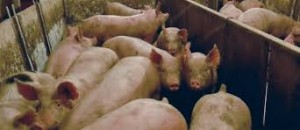As Hog Farms Proliferate, So Too Do Water Problems
An Iowa state water assessment released in 1017 found that 750 of Iowa’s waterways of the 1350 tested were “impaired.”
Large hog farms are undoubtedly a major contributor to that “impairment.”
Iowa has more than 6,300 hog farms and about 60 percent of them raise more than 1,000 hogs, which leaves farmers with massive amounts of manure to deal with. More than 10 billion gallons of liquid manure are applied to Iowa fields annually. State records show 800 manure spills between 1996 and 2012. The manure is high in fecal coliform, nitrogen and phosphates.
The situation is essentially the same in the country’s second largest hog producing state, North Carolina. North Carolina also deals with an estimated 10 billion gallons of hog feces and urine waste each year, according to an analysis of state data by the non-profit organization, Environmental Working Group. The waste, like the hog farms themselves, is concentrated: North Carolina has the two highest hog producing counties in the nation. Together they account for 40 percent of the state’s wet waste.
Across the U.S. nitrogen pollution from livestock manure has increased 46 percent over the past 80 years.
A number of pollutants impair Iowa waters but nitrate, which can also get into water from leaky septic tanks, wastewater treatment systems, and certain fertilizers, plagues the state. The pollution, which has been linked to certain cancers, some birth defects and other diseases, exceeded federal limits in 11 of the state’s public water supplies in 2015, according to a state report.
About 300,000 people in the state are on private wells and a University of Iowa study of 475 wells across the state found that 49 percent tested for nitrates, with 12 percent of those above federal safety limits. An additional 43 percent tested for coliform bacteria, which comes from animal or human waste and can make people sick.
In 2016, federal researchers tested the South Fork Iowa River basin before and after hog manure was spread on a field nearby (This is a typical disposal method.) The researchers found multiple harmful bacteria and pathogens in the water after the application, including a surprising amount of hepatitis E. The researchers concluded that there exists
“…a potential role for swine in the spreading of zoonotic pathogens to the surrounding environment.”
As feces contaminated water reaches streams, fish kills are common. One group estimates that almost 5 million fish have been killed by animal waste over the past decade in Iowa streams.
Water use is also heavily dependent on livestock population. Over the entire state in Iowa, livestock accounts for only about 4 percent of water use, but in some agricultural counties the figure can go a high as 95%.
The hard-to-treat antibiotic resistant bacterial infection MSRA is also easily found in swine and swine workers. People who live near large hog operations appear to have about triple the risk of getting MSRA . The US Centers for Diseases Control and Prevention says MRSA is the most concerning of current antibiotic-resistant threats, resulting in about 11,285 deaths annually.
With mounting evidence of the dangers of hog manure to human health and environmental safety, one would expect that Iowa would step up its regulation efforts. The opposite is true. One researcher says that Iowa’s lawmakers are “leaving its people at risk in favor of hogs.”
Environmental Health News reports:
Iowa’s GOP-controlled Legislature has shown little desire to fix this and in fact has moved backwards: This year it forced a $1.2 million budget reduction on the state Department of Natural Resources, the agency charged with overseeing water safety and health. The DNR eliminated the Bureau of Forestry and eight other positions, including the animal feeding operations coordinator.
Source Reference: Environmental Health News.





